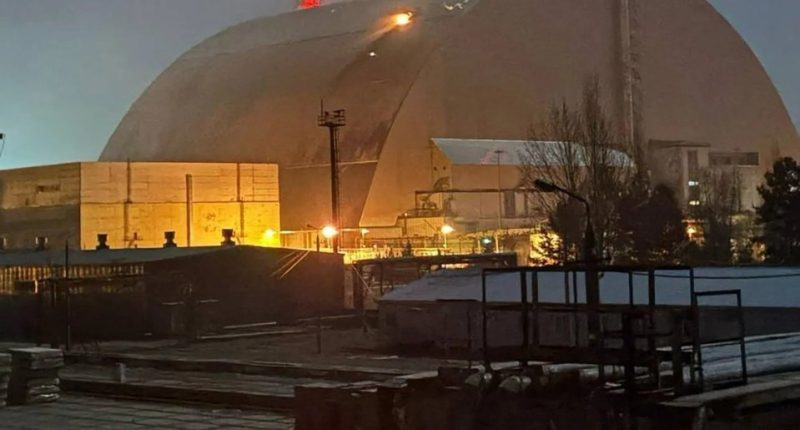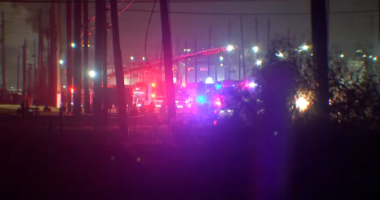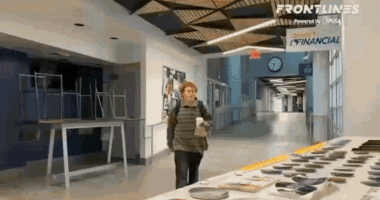Share this @internewscast.com
A RUSSIAN drone collided with Chernobyl’s protective dome, heightening concerns that another attack might release hazardous radiation across Europe, a senior Ukrainian official has cautioned.
Maintenance chief Artem Siryi informed The Sun that one of Vladimir Putin’s kamikaze drones penetrated the steel barrier protecting the notorious Reactor 4.
The attack on February 14 sparked fires between its two essential layers, damaging an important internal membrane meant to contain the radiation.
Siryi, head of maintenance at the New Safe Confinement (NSC), said: “We were very lucky that the strike did not hit the concrete shelter structure that holds the radiation in.
“If it had landed in a different spot, it could’ve compromised the concrete sarcophagus enveloping the reactor. Then we’d be dealing with a very different situation.”
But the expert warned that a second drone strike could be enough to bring the dome down and trigger a full-scale radiation leak if the structure is not repaired as soon as possible.
Speculating a worst case scenario, Siryi said the whole dome could collapse, fully exposing the concrete sarcophagus around Reactor 4.
In a chain reaction, the sarcophagus could eventually get damaged and leak the deadly radiation in a ‘Chernobyl 2.0’.
“If another drone hits, it could collapse part of the structure,” he said.
“That would mean radioactive dust, with particles of nuclear fuel from Unit 4, escaping into the environment.”
“Protecting against extreme outside strikes was not the purpose of this dome,” Siryi added.
The Chernobyl Nuclear Power Plant is protected by a vast multi-layered system.
At its heart is the original concrete sarcophagus built after the 1986 explosion to contain radioactive material.
Surrounding that is the New Safe Confinement—an enormous steel dome completed in 2016 and stretching 100 metres high.
It was designed as a dual-skin steel shield that arches over the original 1986 sarcophagus to further seal off radiation and allow safe dismantling of the reactor beneath.
It also acts as a containment zone to trap radioactive dust using negative pressure and a sealed membrane.
But that outer arch was never built to withstand the force of Mad Vlad’s brutal war in Ukraine.
DOME CHAOS
According to Siryi, the drone directly hit the outer metal cladding over the structure’s central crane maintenance garage, blasting a 15-square-metre hole.
The remains of the drone, including its engine, penetrated the second, inner layer and landed inside the garage.
That initial impact sparked a hidden inferno within the arch’s “layered cake” of materials — metal cladding, Rockwool insulation, and a crucial 1.5mm sealing membrane.
“When the fire started smouldering under the insulation, it was almost impossible to detect from the outside,” Siryi said.
“We had to use drones with thermal imaging to find the fire hidden inside the layers.”
To stop the flames from spreading beneath the outer shell, firefighters were forced to cut dozens of small access hatches — about 30 by 30cm — into the dome, pouring water into the insulation from above.
But temperatures plunged to minus 16°C, freezing the water and blocking access paths, forcing responders to drill even more holes.
“It was a nightmare,” Siryi said.
“This project was never designed to deal with a direct military strike. We had to invent solutions on the fly.”
Roughly 30 per cent of the membrane on the northern part of the arch was destroyed in the blaze — a major concern since this air-tight barrier is what maintains pressure that prevents the lethal radiation from escaping.
The damage also extended to the membrane seal between the steel arch and the ground-level concrete structures, leaving a one-metre-wide breach under the dome.
“We now have breaches where the membrane has burned out — this means the design sealing properties are lost,” Siryi explained.
“Without the membrane, the arch can’t maintain the air pressure regime that prevents radioactive particles from leaking.”
Sensors also detected a brief seismic shock from the explosion, but there was no damage to the internal concrete structure beneath the arch, which still holds dangerous remains of nuclear fuel.
REPAIR PLANS UNDERWAY
Engineers are also monitoring the dome’s structural integrity in case of non-military threats like seismic activity.
“A relatively big tremor could also collapse the dome,” Siryi noted.
With Ukraine’s nuclear legacy once again under threat from war, experts are now warning that the danger of a second Chernobyl disaster is no longer unthinkable.
Ukrainian forces are now stationed in the exclusion zone to protect the area.
Siryi would not say whether he believes the strike was deliberate, but confirmed that surveillance footage showed a “pretty direct strike on the dome, leading to the fire.”
Engineers have now completed a damage survey and drafted a Defect Act.
Immediate priority works include patching the main impact hole, sealing the firefighter-drilled access ports, and replacing the destroyed section of membrane — likely with a non-flammable material.
This project was never designed to deal with a direct military strike
Artem Siryi
But that’s just the beginning.
Siryi said full repairs are a logistical nightmare, complicated by tight access, radiation exposure, and the enormous size of the arch.
“It’s technically difficult,” he said.
“Just getting equipment close enough is a challenge, especially around the stormwater basins and tight ground clearances.”
While work is expected to begin this year, progress depends on funding.
Estimates for the initial emergency works run into “millions of hryvnias”—equivalent to hundreds of thousands of pounds.
The European Bank for Reconstruction and Development (EBRD) has already agreed to fund the surveys and design of the repair plan through the international Chernobyl Cooperation Fund.
But approval for the physical work is still pending.
“Our goal is to complete the priority tasks this year,” Siryi said.
“After that, we’ll test whether the ventilation system can still maintain the proper under-arch conditions. If not, we’ll have to develop an entirely new safety strategy.”
Siryi added: “This is not just about patching a hole. This is about protecting the world from another radioactive disaster.”
What happened at Chernobyl?

WHEN an alarm bellowed out at the nuclear plant on April 26, 1986, workers looked on in horror as the control panels signaled a major meltdown in the number four reactor.
The safety switches had been switched off in the early hours to test the turbine but the reactor overheated and generated a blast – the equivalent of 500 nuclear bombs.
The reactor’s roof was blown off and a plume of radioactive material was blasted into the atmosphere.
As air was sucked into the shattered reactor, it ignited flammable carbon monoxide gas causing a fire which burned for nine days.
The catastrophe released at least 100 times more radiation than the atom bombs dropped on Nagasaki and Hiroshima.
Soviet authorities waited 24 hours before evacuating the nearby town of Pripyat – giving the 50,000 residents just three hours to leave their homes.
After the accident traces of radioactive deposits were found in Belarus where poisonous rain damaged plants and caused animal mutations.
But the devastating impact was also felt in Scandinavia, Switzerland, Greece, Italy, France and the UK.
An 18-mile radius known as the “Exclusion Zone” was set up around the reactor following the disaster.
Most recently, on February 24, 2022 during the Russian invasion, Ukraine lost control over the Chernobyl site.
An adviser to the Ukrainian President, Mykhailo Poldoliak, told reporters: “After a fierce battle, our control over the Chernobyl site was lost.
“The condition of the former Chernobyl nuclear power plant, confinement, and nuclear waste storage facilities is unknown.”
That same day Russian troops descended upon Chernobyl, capturing the area rapidly and killing those who stood in their way.
Ukrainian President Volodymyr Zelensky tweeted that day in response to the events, “Russian occupation forces are trying to seize the Chernobyl [Nuclear Power Plant]. Our defenders are sacrificing their lives so that the tragedy of 1986 will not be repeated.
“This is a declaration of war against the whole of Europe.”
Anton Herashchenko, an adviser to the interior minister, told The New York Times that Ukrainian troops had put up a “fierce resistance,” but warned, “radioactive dust could cover the territory of Ukraine, Belarus and the countries of the European Union.”

























